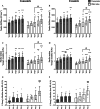Muscle and tendon adaptations to moderate load eccentric vs. concentric resistance exercise in young and older males
- PMID: 34196903
- PMCID: PMC8492846
- DOI: 10.1007/s11357-021-00396-0
Muscle and tendon adaptations to moderate load eccentric vs. concentric resistance exercise in young and older males
Abstract
Resistance exercise training (RET) is well-known to counteract negative age-related changes in both muscle and tendon tissue. Traditional RET consists of both concentric (CON) and eccentric (ECC) contractions; nevertheless, isolated ECC contractions are metabolically less demanding and, thus, may be more suitable for older populations. However, whether submaximal (60% 1RM) CON or ECC contractions differ in their effectiveness is relatively unknown. Further, whether the time course of muscle and tendon adaptations differs to the above is also unknown. Therefore, this study aimed to establish the time course of muscle and tendon adaptations to submaximal CON and ECC RET. Twenty healthy young (24.5 ± 5.1 years) and 17 older males (68.1 ± 2.4 years) were randomly allocated to either isolated CON or ECC RET which took place 3/week for 8 weeks. Tendon biomechanical properties, muscle architecture and maximal voluntary contraction were assessed every 2 weeks and quadriceps muscle volume every 4 weeks. Positive changes in tendon Young's modulus were observed after 4 weeks in all groups after which adaptations in young males plateaued but continued to increase in older males, suggesting a dampened rate of adaptation with age. However, both CON and ECC resulted in similar overall changes in tendon Young's modulus, in all groups. Muscle hypertrophy and strength increases were similar between CON and ECC in all groups. However, pennation angle increases were greater in CON, and fascicle length changes were greater in ECC. Notably, muscle and tendon adaptations appeared to occur in synergy, presumably to maintain the efficacy of the muscle-tendon unit.
Keywords: Ageing; Eccentric; Muscle; Submaximal RET; Tendon.
© 2021. The Author(s).
Conflict of interest statement
The authors declare no competing interests.
Figures






Similar articles
-
Architectural, functional and molecular responses to concentric and eccentric loading in human skeletal muscle.Acta Physiol (Oxf). 2014 Mar;210(3):642-54. doi: 10.1111/apha.12225. Acta Physiol (Oxf). 2014. PMID: 24387247
-
Longitudinal hypertrophic and transcriptional responses to high-load eccentric-concentric vs concentric training in males.Scand J Med Sci Sports. 2020 Nov;30(11):2101-2115. doi: 10.1111/sms.13791. Epub 2020 Aug 26. Scand J Med Sci Sports. 2020. PMID: 32762021
-
Comparison between concentric-only, eccentric-only, and concentric-eccentric resistance training of the elbow flexors for their effects on muscle strength and hypertrophy.Eur J Appl Physiol. 2022 Dec;122(12):2607-2614. doi: 10.1007/s00421-022-05035-w. Epub 2022 Sep 15. Eur J Appl Physiol. 2022. PMID: 36107233
-
Skeletal Muscle Remodeling in Response to Eccentric vs. Concentric Loading: Morphological, Molecular, and Metabolic Adaptations.Front Physiol. 2017 Jul 4;8:447. doi: 10.3389/fphys.2017.00447. eCollection 2017. Front Physiol. 2017. PMID: 28725197 Free PMC article. Review.
-
Comparison Between Eccentric vs. Concentric Muscle Actions On Hypertrophy: A Systematic Review and Meta-analysis.J Strength Cond Res. 2025 Jan 1;39(1):115-134. doi: 10.1519/JSC.0000000000004981. J Strength Cond Res. 2025. PMID: 39652733
Cited by
-
Impaired lower limb muscle mass, quality and function in end stage liver disease: A cross-sectional study.Exp Physiol. 2023 Aug;108(8):1066-1079. doi: 10.1113/EP091157. Epub 2023 May 11. Exp Physiol. 2023. PMID: 37166422 Free PMC article.
-
Muscle-tendon unit design and tuning for power enhancement, power attenuation, and reduction of metabolic cost.J Biomech. 2023 May;153:111585. doi: 10.1016/j.jbiomech.2023.111585. Epub 2023 Apr 13. J Biomech. 2023. PMID: 37126884 Free PMC article. Review.
-
Stimuli for Adaptations in Muscle Length and the Length Range of Active Force Exertion-A Narrative Review.Front Physiol. 2021 Oct 8;12:742034. doi: 10.3389/fphys.2021.742034. eCollection 2021. Front Physiol. 2021. PMID: 34690815 Free PMC article. Review.
-
Putting "Heavy" into Heavy Slow Resistance.Sports Med. 2022 Jun;52(6):1219-1222. doi: 10.1007/s40279-022-01641-y. Epub 2022 Jan 27. Sports Med. 2022. PMID: 35084703 Free PMC article.
-
Hydrolysed Collagen Supplementation Enhances Patellar Tendon Adaptations to 12 Weeks' Resistance Training in Middle-Aged Men.Eur J Sport Sci. 2025 Apr;25(4):e12281. doi: 10.1002/ejsc.12281. Eur J Sport Sci. 2025. PMID: 40100255 Free PMC article. Clinical Trial.
References
Publication types
MeSH terms
Grants and funding
LinkOut - more resources
Full Text Sources

